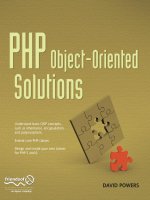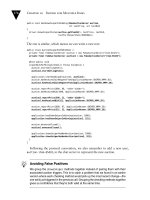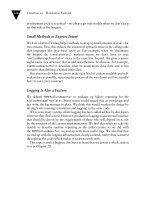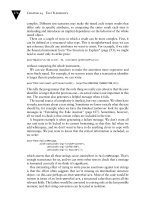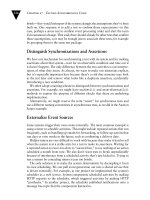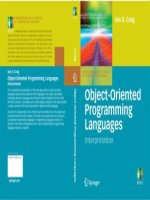Object oriented Game Development -P5 doc
Bạn đang xem bản rút gọn của tài liệu. Xem và tải ngay bản đầy đủ của tài liệu tại đây (258.45 KB, 30 trang )
// MyClass.hpp
#include "package\package_Type.hpp"
class MyClass : public package_Type
{
public:
// Your operations here.
};
If this is a bit too abstract, let’s look at a real-life example. One project had a
package to handle game controllers. These game controllers could come in vari-
ous flavours: joypad, keyboard, mouse, etc. The package defined a polymorphic
handler class that accepted different types of input data:
class ctrl_InputHandler
{
public:
virtual void HandleJoy( ctrl_Joypad & aJoy, ??? );
// Other controller types handled similarly.
};
The idea is that the client writes their own input handler to do whatever they
require it to do. However, there are a couple of things we needed to specify:
something about who was using the controller, and something about what was
being controlled. This was done by using two Strawman classes:
class ctrl_User
{
public:
ctrl_User() {}
virtual ~ctrl_User() {}
};
class ctrl_Target
{
public:
ctrl_Target() {}
virtual ~ctrl_Target() {}
};
The handler class now has member functions of the form:
void HandleJoy( ctrl_Joy & aData,
ctrl_User * pUser,
ctrl_Target * pTarget );
Object-oriented game development106
8985 OOGD_C04.QXD 1/12/03 2:32 pm Page 106
At the game level, we had a player owning a controller and using it to move a
cursor to drive it around the screen (Figure 4.5).
The game’s input handler code looked something like this:
// GameInputHandler.hpp
#include "controller\ctrl_InputHandler.hpp"
class GameInputHandler : public ctrl_InputHandler
{
public:
void HandleJoy( ctrl_Joy& aData,
ctrl_User * pUser,
ctrl_Target * pTarget );
};
// GameInputHandler.cpp
#include "GameInputHandler.hpp"
#include "Player.hpp"
#include "Cursor.hpp"
void GameInputHandler::HandleJoy( ctrl_Joy& aData,
ctrl_User * pUser,
ctrl_Target * pTarget )
{
// This upcast is fine because we know what
// the final user type is at the game level.
Player * pPlayer = static_cast<Player *>(pUser);
// Similarly, at this level that target is always
// the cursor.
Cursor * pCursor = static_cast<Cursor *>(pTarget);
// Code to do things with players and cursors…
}
Object-oriented design for games 107
ctrl_InputHandler
Controller
GameInputHandler
Game
ctrl_User Player
ctrl_Target Cursor
Figure 4.5
The game subclasses of
the abstract component
classes.
8985 OOGD_C04.QXD 1/12/03 2:32 pm Page 107
4.3.7 Prototype
A prototype is similar to a factory, in as much as it creates new object instances.
However, it does this not by taking some type identifier and returning an associ-
ated class, but by cloning itself:
class PrototypeBase
{
public:
virtual PrototypeBase * Clone() = 0;
};
class Prototype1 : public PrototypeBase
{
public:
// Cloning without copying makes no sense!
Prototype1( const Prototype1 & that )
{
// …
}
// Note the use of the ‘covariant return type’
// rule now supported by most C++ compilers: a
// virtual function that returns a base class
// pointer or reference
// with an override in a subclass can declare its
// return type to be the subclass type.
Prototype1 * Clone()
{
return new Prototype1( *this );
}
};
Another factory-like class then uses the prototype thus:
class PrototypeFactory
{
public:
void SetPrototype( PrototypeBase * pBase )
{
delete m_pPrototype;
m_pPrototype = pBase;
}
PrototypeBase * Create()
{
return( m_pPrototype->Clone() );
}
Object-oriented game development108
8985 OOGD_C04.QXD 1/12/03 2:32 pm Page 108
private:
PrototypeBase * m_pPrototype;
};
The prototype is useful because it can be used to set default values in a dynamic
way:
PrototypeFactory MyFactory;
Prototype1 * pProto1 = new Prototype1( 10 );
MyFactory.SetPrototype( pProto1 );
PrototypeBase * pInstance1 = MyFactory.Create();
Prototype1 * pProto2 = new Prototype1( 20 );
MyFactory.SetPrototype( pProto2 );
PrototypeBase * pInstance2 = MyFactory.Create();
Here’s an example of a prototype system in action. We have a game in which a
player has a weapon that can shoot various types of bullets (see Figure 4.6 for
some lines and bubbles). This translates into the following code skeleton:
// Weapon.hpp
class Bullet;
class Weapon
{
public:
Bullet * CreateBullet();
void SetBulletPrototype( Bullet * pBullet );
private:
Bullet * m_pBulletPrototype;
};
Object-oriented design for games 109
BulletStandard
Weapon
Bullet
BulletArmourPiercing
BulletPrototype
Figure 4.6
Class diagram for
weapon and bullet
management system.
8985 OOGD_C04.QXD 1/12/03 2:32 pm Page 109
// Weapon.cpp
#include "Weapon.hpp"
#include "Bullet.hpp"
void Weapon::SetBulletPrototype( Bullet * pProto )
{
delete m_pBulletPrototype;
m_pBulletPrototype = pProto;
}
/*virtual*/
Bullet * Weapon::CreateBullet()
{
return( m_pBulletPrototype->Clone() );
}
//
// Bullet.hpp
class Bullet
{
public:
Bullet();
Bullet( const Bullet & that );
virtual Bullet * Clone() = 0;
// and other methods.
private:
// some data fields.
};
//
// BulletStandard.hpp (BulletArmourPiercing is similar)
#include "Bullet.hpp"
#include "maths\maths_Vector3.hpp"
class BulletStandard : public Bullet
{
public:
BulletStandard();
BulletStandard( const BulletStandard & that );
BulletStandard * Clone();
private:
maths_Vector3 m_vPosition;
// and other fields
};
//
Object-oriented game development110
8985 OOGD_C04.QXD 1/12/03 2:32 pm Page 110
// BulletStandard.cpp
#include "BulletStandard.hpp"
BulletStandard::
BulletStandard( const BulletStandard & that )
: Bullet( that )
, m_vPosition( that.m_vPosition )
{
}
/*virtual*/
BulletStandard * BulletStandard::Clone()
{
return( new BulletStandard( *this ) );
}
Now the player (say) can change the type of ammo their weapon shoots by writing:
Weapon * pWeapon = GetWeapon();
pWeapon->SetBulletPrototype( new BulletStandard );
4.3.8 Russian doll
The aim of this mini-pattern is to eliminate global-like objects, by which we
mean real globals (which are anathema) or singletons (which are tolerable but
not aesthetically satisfying).
I was tempted to call this pattern a Trojan horse, but that had certain nega-
tive connotations. However, the idea is much the same – allow an object type to
hide encapsulated details of other objects from a system that it passes through
on its way into another system further down the hierarchy. The bypassed
system therefore remains oblivious – and therefore independent – of anything
contained in the object itself (the ‘Trojans’, if you will).
We will call the global-like objects ‘services’ and consider a non-horizontal
object hierarchy where the objects all depend on a selection of those services, a
bit like that shown in Figure 4.7.
Object-oriented design for games 111
Object
Subclass 1
Subclass 2
Service 1
Service 2s2
s1
Figure 4.7
The ‘Russian doll’
pattern works well for
object hierarchies that
look like this.
8985 OOGD_C04.QXD 1/12/03 2:32 pm Page 111
Let’s look at how the constructors of the subclasses might appear:
// Subclass1.cpp
Subclass1::Subclass1( Service1 * pService1 )
: m_pService1( pService1 )
{
/* Service1 assumed to be private */
}
// Subclass2.cpp
Subclass2::
Subclass2( Service2 *pService2, Service1 *pService1 )
: Subclass1( pService1 )
, m_pService2( pService2 )
{
}
Notice that the deeper the hierarchy gets, the more arguments the constructors
need. Long argument lists aren’t just ugly; they are also a fertile source of mis-
takes because of things like automatic type conversion. Furthermore, notice that
Subclass2 gets to see a Service1 pointer even though it never uses or cares about
it. To create a Subclass2, we’d write something like:
// Things.cpp
#include "Service1.hpp"
#include "Service2.hpp"
//…
Service1 * pService1 = Service1::Instance();
Service2 * pService2 = Service2::Instance();
Subclass2 * pThing = new Subclass2(pService1, pService2);
Those global-like objects have a habit of popping up everywhere and getting
passed around everywhere. We can tame this sort of creeping disease quite
simply by using a container class – a Russian doll:
// ServiceProvider.hpp
class ServiceProvider
{
public:
Service1 * GetService1();
Service2 * GetService2();
Object-oriented game development112
8985 OOGD_C04.QXD 1/12/03 2:32 pm Page 112
private:
Service1 * m_pService1;
Service2 * m_pService2;
};
Now we can write our constructors like this:
// Subclass1.cpp
#include "ServiceProvider.hpp"
Subclass1::Subclass1( ServiceProvider & rServices )
: m_pService1( rServices.GetService1() )
{
}
// Subclass2.cpp
#include "ServiceProvider.hpp"
Subclass2::Subclass2( ServiceProvider & rServices )
: Subclass1( rServices )
, m_pService2( rServices.GetService2() )
{
}
No more growing argument lists, and only the classes that actually require par-
ticular services need request and use them.
Case study 4.3: patterns in practice – the ‘state manager’
Having talked quite abstractly about patterns, we’ll now demonstrate their use in a
case study. We’ll discuss in detail the development of a state manager for a game (or
indeed any other sort of application).
First, what (in this context) is a state? It is a single mode of behaviour that deter-
mines what the game is doing at any one time. For example, the game may be playing
a cut scene, in a menu hierarchy, running the main game or paused. Each of these
behaviours we call a state; Figure 4.8 shows some state classes. As always, we start
by factoring out common behaviours: what is there that is similar to all states?
Looking at the examples above, we can infer that there is a concept of time passing
(a cut scene plays or the game evolves): the state can be updated with respect to
time. How do we measure time? In a game, we can either count elapsed frames or
measure actual elapsed time. Which is better? That’s another argument, which we’ll
deal with in a later chapter. For now, let’s just assume we have a type
Time that rep-
resents the elapsed interval since the last update.
Object-oriented design for games 113
8985 OOGD_C04.QXD 1/12/03 2:32 pm Page 113
What else is common to state? We’d certainly like to be able to see some visual dif-
ference between states, so we’d like to
Draw what’s going on. Again, for argument’s
sake, we’ll assume we have a
Renderer class that can draw stuff:
class state_State
{
public:
state_State();
virtual ~state_State();
virtual void Update( Time dt ) = 0;
virtual void Draw( Renderer * pRenderer ) const = 0;
};
Note that the Draw member is declared const: it shouldn’t modify the state. What
else can we say about states? Well, our application will, at some point, have to
change state. Zero or one state will be outgoing and another one other will be incom-
ing. These states may require initialisation and clean-up operations, so to this end we
extend the interface by adding two virtual methods,
OnEnter() and OnLeave():
class state_State
{
public:
state_State();
virtual ~state_State();
virtual void Update( Time dt ) = 0;
virtual void Draw( Renderer * pRenderer ) const = 0;
virtual void OnEnter() { ; }
virtual void OnLeave() { ; }
};
Object-oriented game development114
CutSceneState
MenuState
OptionsMenuStateMainMenuState
State
PauseStateGameState
Figure 4.8
Examples of state
subclasses.
8985 OOGD_C04.QXD 1/12/03 2:32 pm Page 114
We have avoided passing the outgoing and incoming states as parameters into these
member functions, even though that might give more power and flexibility. Why?
Because at this relatively low level, binding states to each other makes it harder to write
a higher-level state that is as autonomous as it needs to be. If we really need to imple-
ment this sort of behaviour, then we can still do so further down the class hierarchy.
The sequence of operations involved in a state change is detailed in this code fragment:
void ChangeState( state_State *pFrom, state_State *pTo )
{
if ( pFrom != 0 )
{
pFrom->OnLeave();
}
pTo->OnEnter();
}
Simple enough. (Of course, production code would be more robust – what happens if
pTo is NULL? Nothing good, that’s for sure, so the validity of the parameters needs to
be asserted on entry.)
Now, a more awkward question: who owns the states? Who is responsible for creat-
ing, deleting and using states? The most obvious candidate is the application itself,
as shown in Figure 4.9.
But – as ever – ‘obvious’ is not necessarily best. Anyone can create and destroy
states arbitrarily, and that can lead anywhere from crashes – immediate or latent – to
memory leaks, and we would like to avoid these if possible. This is just the sort of
situation where a manager can help, centralising the point of creation and helping us
to enforce the correct transitions from state to state.
Object-oriented design for games 115
Application
Application State
ConcreteState
*StatesCurrent
state_State
Figure 4.9
The application
subclasses of the
abstract state class.
8985 OOGD_C04.QXD 1/12/03 2:32 pm Page 115
class state_StateManager
{
public:
state_StateManager();
~state_StateManager();
void SwitchToState( state_State * pState )
{
if ( m_pCurrentState != 0 )
{
m_pCurrentState->OnLeave();
}
m_pCurrentState = pState;
m_pCurrentState->OnEnter();
}
private:
state_State * m_pCurrentState;
};
The revised layout is shown in Figure 4.10.
Fine. But now we have another problem: the state manager is now creating the states
that are required to make our application tick. How do we avoid coupling the state
manager to our particular application manufacturing concrete states? Sounds like a
job for a factory:
class state_Factory
{
public:
state_State * CreateState( /*???*/ ) = 0;
};
Object-oriented game development116
Application
Application State
ConcreteState
state_State
state_StateManager
*States Current
State manager
Figure 4.10
The application
implements concrete
versions of the abstract
state class.
8985 OOGD_C04.QXD 1/12/03 2:32 pm Page 116
This is illustrated in Figure 4.11. Now, about that comment in the parameter list of
CreateState(). Although an enumerated integer would suffice to describe the vari-
ous states required, we have seen that this results in a highly coupled and therefore
dependent set of modules that will force rebuilds left, right and centre. So let’s avoid
that and use names to uniquely identify states.
5
We’re not dealing with inner-loop code
that needs to run lightning quick – the application changes state relatively infrequently,
so the occasional string compare won’t hurt at all.
class state_Factory
{
public:
state_State * CreateState( const char * pName ) = 0;
};
This forms the basis of our state management system. There are still some details to
thrash out, though. Remember our state change pattern ‘leave current, enter new’?
Sometimes we might need to have a more complex behaviour, because we shall want
to change behaviour of the state we are entering depending on what state we are
leaving. Earlier, we rejected putting this sort of behaviour into the state class to keep
the design simple and clean. Now we can see that it is the job of the state manager
to control the transitions between application states. So we make that
SwitchToState() method virtual, allowing the application to subclass and override
to get the required specific behaviour (Figure 4.12):
Object-oriented design for games 117
Application
Application State
ConcreteState
state_State
state_StateManager
*States Current
State manager
ConcreteStateFactory state_Factory
Factory
Figure 4.11
State manager with
factory.
5 For the sake of sanity, ensure case-independent comparison of names.
8985 OOGD_C04.QXD 1/12/03 2:32 pm Page 117
class state_StateManager
{
public:
state_StateManager();
virtual ~state_StateManager();
virtual void SwitchToState( state_State * pState )
{
/* As before */
}
private:
state_State * m_pCurrentState;
};
Another inspection of our class diagram might suggest that the state manager class
might be a candidate for a singleton. Quite so! There is logically only one state man-
ager – why would we need more? – but since it is hard, nay impossible, to inherit from
a singleton (what with those private constructors and destructors), it is important that
it is the subclass, not the base class, of
state_StateManager that is a singleton.
In fact, the manager is not the only class in the system that is a natural singleton.
The state subclasses themselves are unique, so the creation functions passed to the
concrete state factory can return the singleton instance rather than
new’ing a sub-
class. This hugely reduces the likelihood of memory leaking, being multiply deleted,
or other related horrors.
// ConcreteState.hpp
#include "state_State.hpp"
Object-oriented game development118
Application
Application State
ConcreteState
state_State
state_StateManager
*States Current
State manager
ConcreteStateFactory state_Factory
Factory
AppStateManager
Figure 4.12
Custom state
management.
8985 OOGD_C04.QXD 1/12/03 2:32 pm Page 118
class ConcreteState : public state_State
{
public:
static ConcreteState & Instance();
void Update( Time dt );
void Draw( Renderer * pRenderer ) const;
private:
// …
};
// ConcreteState.cpp
#include "ConcreteState.hpp"
#include "ConcreteStateManager.hpp"
#include "ConcreteStateFactory.hpp"
namespace
{
state_State * createState()
{
return( &ConcreteState::Instance() );
}
bool registerState()
{
ConcreteStateManager & aSM =
ConcreteStateManager::Instance();
state_Factory * pSF = aSM.GetFactory();
return( pSF->Register( "Concrete", createState ) );
}
}
/*static*/
ConcreteState & ConcreteState::Instance()
{
static ConcreteState anInstance;
return( anInstance );
}
Object-oriented design for games 119
8985 OOGD_C04.QXD 1/12/03 2:32 pm Page 119
In engineering the state package in this fashion, we have established a paradigm: the
way a system works. Take a look at how the application’s main loop might be written:
Time t1 = GetTime();
Time dt = 0;
for(;;)
{
ConcreteStateManager & aSM =
ConcreteStateManager::Instance();
state_State * pState = aSM.GetCurrentState();
if ( pState != 0 )
{
pState->Update( dt );
pState->Draw( pRenderer );
}
Time t2 = GetTime();
dt = t2 – t1;
t1 = t2;
}
We have a simple main loop, and a set of decoupled, largely independent states that can
benefit further from inheritance to propagate common behaviours to state subclasses.
This illustrates the benefits of moving to a pattern-driven, object-oriented programming
methodology. Although a similar state system could, in principle, be written in C, the
semantics of C++ make the code clear to understand, extend and maintain.
We’ll return to the state management system later when we discuss adding actual
data and graphics to the model.
Case study 4.4: graphical user interface
There isn’t a game on the planet that doesn’t have a user interface (UI), a method for
taking changes in a controller and translating that into actions and responses in the
game. This suggests that UIs are eminently abstractable, but we need to be a bit care-
ful here because modern UIs usually come with complex graphical representations and
we should be watchful to abstract only the generic behaviour common to all interface
systems, lest we end up with specific behaviour at too low a level for reusability.
The graphical bit
For historical and habitual reasons, we’ll assume that the basic package name for
the GUI graphical bit is called ‘view’. In order to keep the view package clean and
simple, we need to avoid references to particular platforms and particular ways of
Object-oriented game development120
8985 OOGD_C04.QXD 1/12/03 2:32 pm Page 120
drawing things. We’ll make an assumption first: all graphical elements are repre-
sented by 2D rectangular areas. This isn’t necessarily the most general way of
storing region data, and it is possible to use non-rectangular regions for a truly univer-
sal representation. Nevertheless, whatever shape we choose, it will be bounded by a
rectangle. For a few shapes, the rectangle will be a less efficient bound, but for the
current purpose rectangles will do fine.
We’ll look at the representation of the rectangle soon. But let’s define the class that
drives the whole GUI system – the View. A View is a rectangular region of screen that
knows how to draw itself. It also supports the notion of hierarchy. A View can have
child Views: when you perform an operation on a View, you implicitly affect all of its
children as well (Figure 4.13).
This translates naturally to code that might look something like this:
// File: view_View.hpp
#include <list>
#include "view_Rectangle.hpp"
class view_View;
typedef std::list<view_View *> tViewList;
class view_View : public view_Rectangle
{
public:
view_View();
virtual ~view_View();
virtual void Render()const = 0;
void AddChild( view_View * const pChild );
void RemoveChild( view_View * const pChild );
void RemoveAllChildren();
Object-oriented design for games 121
view_View
View
*Children
view_Rectangle
Figure 4.13
Basic view classes.
8985 OOGD_C04.QXD 1/12/03 2:32 pm Page 121
private:
std::list<view_View *> m_Children;
};
// File: view_View.cpp
#include "view_View.hpp"
#include <algorithm>
// Function objects that perform per-view tasks.
struct ViewDeleter
{
inline void operator()( view_View * pView )
{
delete pView;
}
};
struct ViewRenderer
{
inline
void operator()( view_View const * pView ) const
{
pView->Render();
}
};
view_View::view_View()
: view_Rectangle()
{
}
view_View::~view_View()
{
// Delete all child views.
std::for_each( m_Children.begin(),
m_Children.end(),
ViewDeleter() );
}
/*virtual*/ void view_View::Render() const
{
// Base class must render all child views.
std::for_each( m_Children.begin(),
m_Children.end(),
ViewRenderer() );
}
Object-oriented game development122
8985 OOGD_C04.QXD 1/12/03 2:32 pm Page 122
Notice that the Render() method is pure but implemented. This keeps the
view_View class abstract, as at this level we don’t define so much what we do as
how we do it. This has a subtle repercussion on how we define the base rectangle.
The key question is ‘How do we represent a 2D position on the view?’ Consider a
game that uses a type of view called a layered view. This defines a precise order of
drawing for a series of controlled views called layers. Each of the layers has an associ-
ated integer depth and the layers are rendered in order lowest to highest (Figure 4.14).
(You are permitted to either shudder or marvel at the recursivity here: a layered view is a
view that contains layers that are also views, ergo they can be layered views.)
Now, consider how we might define the concept of position for a View. In the base
system, an x and a y ordinate suffice. However, in the layered system, the depth is
required to define a position uniquely. This suggests that making the concept of loca-
tion abstract is essential to a generic representation (Figure 4.15).
Now it becomes the job of the view subclasses to redefine the concept of position
should it be required. Each view supports a factory method, a virtual function that
manufactures the correct type of positional descriptor.
Object-oriented design for games 123
Layer
Application
depth
LayeredView
view_View
View
*Children
view_Rectangle
int
*Layers
Figure 4.14
Using the view_View
class.
view_View
View
view_Rectangle
view_View
*Children
view_Position
view_Scalar
x y
Position
Height
Width
Figure 4.15
Adding position to the
rectangle.
8985 OOGD_C04.QXD 1/12/03 2:32 pm Page 123
// File: view_Types.hpp
typedef float view_Scalar;
// File: view_Position.hpp
#include "view_Types.hpp"
class view_Position
{
public:
// Public interface omitted for brevity.
private:
view_Scalar m_x;
view_Scalar m_y;
};
// File: view_Rectangle.hpp
#include "view_Position.hpp"
class view_Rectangle
{
public:
// Public interface omitted for brevity.
private:
view_Position * m_pPosition;
view_Scalar m_Width;
view_Scalar m_Height;
};
// File: view_View.hpp
#include "view_Rectangle.hpp"
class view_View : public view_Rectangle
{
public:
virtual view_Position * CreatePosition()
{
return new view_Position;
}
// Remainder omitted for brevity.
Object-oriented game development124
8985 OOGD_C04.QXD 1/12/03 2:32 pm Page 124
private:
};
// File: LayeredView.hpp
#include "view_View.hpp"
class LayeredPosition : public view_Position
{
public:
// Public interface omitted for brevity.
private:
int m_iDepth;
};
class LayeredView : public view_View
{
// Class body omitted for brevity.
};
There’s one more issue to cover: drawing the view. Notice that we provided an
abstract method
virtual void view_View::Render() const = 0;
to do our rendering. It is a bit annoying that we cannot pass a parameter in to say
what we are rendering to, and how. Of course, if we did that, then we could start to
eat away at a generic representation. So how do we pass in context information with-
out resorting to specific implementation details? We use a Strawman object. Recall
that this is an empty class used to supply type information only. In this example, we
are passing in an arbitrary context, which the concrete rendering method will know
how to convert into something useful:
// File: view_Context.hpp
class view_Context
{
public:
view_Context();
virtual ~view_Context();
private:
};
// File: view_View.hpp
Object-oriented design for games 125
8985 OOGD_C04.QXD 1/12/03 2:32 pm Page 125
class view_Context;
class view_View
{
// As before, except –
virtual void Render(view_Context *pContext) const=0;
};
Now, supposing that our application has a render package that defines a renderer
class:
class rndr_Renderer
{
// Lots of funky graphics stuff
};
Then we can define the application renderer thus:
class Renderer
: public rndr_Renderer
, public view_Context
{
};
which allows us to pass renderers directly into the application views:
void MyView::Render( view_Context * pContext )
{
rndr_Renderer * pRenderer =
static_cast<rndr_Renderer *>( pContext );
// Draw the view.
// Important and easily forgotten call to render the
// child views.
view_View::Render( pContext );
}
A couple of points. First, if you are still mistrustful of multiple inheritance, you can get
a functionally (but not syntactically elegant) equivalent class by using single inheri-
tance and embedding a renderer instance member with accessors:
class RenderContext : public view_Context
{
public:
rndr_Renderer & GetRenderer() { return m_Renderer; }
Object-oriented game development126
8985 OOGD_C04.QXD 1/12/03 2:32 pm Page 126
private:
rndr_Renderer m_Renderer;
};
Second, we need to rewrite the function object that does the rendering in
view_View.cpp, given that we have added a parameter:
class ViewRenderer
{
public:
// ‘explicit’ stops the compiler trying to convert
// contexts to ViewRenderers at the drop of a hat.
explicit inline
ViewRenderer( view_Context * pContext )
: m_pContext( pContext )
{
}
inline
void operator()( view_View const * pView ) const
{
pView->Render( m_pContext );
}
}
/*virtual*/
void view_View::Render( view_Context * pContext ) const
{
std::for_each( m_Children.begin(),
m_Children.end(),
ViewRenderer( pContext ) );
}
The input system
Now we want to define how player input data are managed. Note that this system is
most definitely not a controller system. It is an adapter component that takes data
from an external controller system (the specifics of which are intentionally not
detailed here) and converts them into a form that is usable by the package and
allows them to be passed to the appropriate subsystem.
The atomic class is naturally called Input and is an abstract object (Figure 4.16).
However, there is one item of data that we associate with all flavours of input data,
and that is an owner tag. This allows us to distinguish where the data came from,
and it should be unique for every potential source of input data. We’ll use an integer
tag field here, though others are feasible.
Object-oriented design for games 127
8985 OOGD_C04.QXD 1/12/03 2:32 pm Page 127
So far, so simple. Assuming that we subclass input_Input to give us a concrete
object, we then need a mechanism to propagate the associated data to some sort of
handler. A C-like solution would be to add a type field to the input data and then
switch that on to pass on the correct data:
void HandleInput( input_Input * pInput )
{
switch( pInput->eType )
{
case IT_JOYPAD:
handleJoypad(((InputJoypad *)pInput)->m_Data);
break;
case IT_KEYBOARD:
handleKeys(((InputKeyboard *)pInput)->m_Data);
break;
// etc
default:
break;
}
}
This isn’t a very flexible system. Adding controller types is a pain – the switch state-
ment can become large and unwieldy and, as we’ve seen before, enumerations are
generally a bit of a bind and a compilation bottleneck. Ideally, if we wanted to extend
an enumerated type, we might like to express it thus:
enum Thing
{
ZERO, /* = 0 */
ONE, /* = 1 */
TWO /* = 2 */
};
Object-oriented game development128
input_Input
Input
int
Owner
Figure 4.16
The input object.
8985 OOGD_C04.QXD 1/12/03 2:32 pm Page 128
enum ExtendedThing : public Thing
{
THREE, /* = 3 */
FOUR, /* = 4 */
};
But since this isn’t allowed, and it could have horrendous side effects if it were, then
it’s better to abandon enums in favour of our flexible friend polymorphism.
The idea is to have a separate object that the application defines and that handles
the various types of input that the application is interested in (and nothing else). This
prevents the clogging effect of low-level monolithic systems. The object that provides
this functionality is called an InputMap. A base InputMap supports a single virtual
function, HandleInput:
class input_InputMap
{
public:
virtual void HandleInput( input_Input & anInput )
{
}
};
Which does precisely nothing. The cunning bit takes place in your subclasses, where
you provide the overloads of HandleInput that do your bidding:
class MyInput : public input_Input
{
// Class body omitted for brevity.
};
class MyInputMap : public input_InputMap
{
public:
virtual void HandleInput( MyInput & anInput )
{
// Do something groovy.
}
};
The hope is that when you call HandleInput with an object of type MyInput, then your
‘Do something groovy’ code gets executed. Sadly, that hope is in vain. What actually
happens is that
input_InputMap::HandleInput() is called. Why? Because C++
can’t do the doubly polymorphic thing – you want it to call the right function depending
not only on the type of input map but also on the type of input. In the lingo, only the
Object-oriented design for games 129
8985 OOGD_C04.QXD 1/12/03 2:32 pm Page 129
static type of arguments can be used to select the function to call (at compile time),
not the dynamic type (at run time like you need).
Thankfully, there are work-arounds. One possibility is to use
dynamic_cast to see
whether type conversions exist, but this leads to inefficient code that is effectively
just a type with a switch – the solution we rejected a while back. The solution we’ll
use here is called ‘double dispatching’. We add an extra virtual function to the Input
class called Dispatch:
class input_InputMap;
class input_Input
{
public:
// As before.
virtual void Dispatch( input_InputMap * pMap ) = 0;
};
Within your own subclasses of input, you then implement Dispatch as follows:
class MyInput : public input_Input
{
public:
void Dispatch( input_InputMap * pMap )
{
pMap->HandleInput( *this );
}
};
This basically turns a dispatch based on two values into two single dispatches, and it
works a treat. That’s because within
MyClass, the type of *this is known at compile
time (it’s always
MyClass), so the compiler always generates exactly the right call.
An
InputMap can – and should – support as many types of input subclass as you
need. If you fail to provide a
HandleInput for a particular input class, then the base
class (do-nothing)
HandleInput is automatically invoked, so you can either flag an
error or ignore the data.
Figure 4.17 summarises the input components.
class MyInputMap
{
public:
void HandleInput( MyInput & anInput );
void HandleInput( InputKeyboard & anInput );
void HandleInput( InputJoypad & anInput );
};
Object-oriented game development130
8985 OOGD_C04.QXD 1/12/03 2:32 pm Page 130

